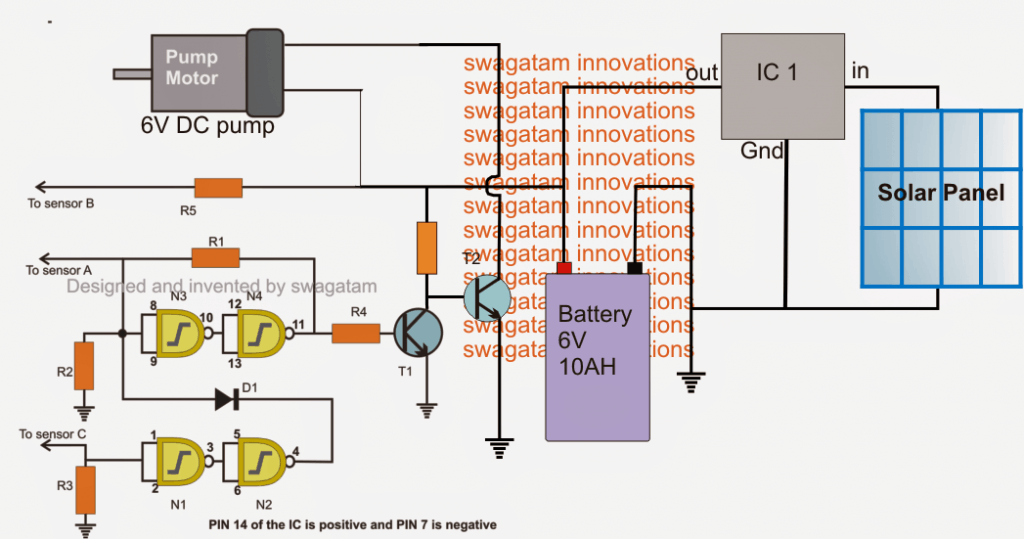This post is about one kind of circuit, which is for controlling the level of water, and this can be useful for making an automatic system that will keep giving water in a dripping manner to plants in a garden that is at home without needing any person to be there. This idea was asked by Mr. Brandon.
Technical Details
I am trying to make one kind of system for giving water in drops to my balcony garden. In this system there is one part that is about how to automatically make the water go into a vessel of size 5 liter or 10 liter (this is the place where water is stored before it goes for dripping to plants) from one more bigger water storage (for times when I am not at my house for a longer time, maybe around 15 days or so). So I have decided to break this full project into many steps which I am explaining below:
- Making the drip irrigation system work by taking one vessel of 5 liters or 10 liters (I will call this vessel V1) and using this vessel as the storage from where water will go to the plants. I think if I use a smaller vessel, then the water pressure may become less.
- Creating one system that pumps water automatically and keeps filling vessel V1 whenever its water becomes low. This water will be taken from the big water storage. If the vessel V1 is already full then the pump motor should stop working but if the water inside vessel V1 goes below a certain level then the motor should start running and fill it again. I want to make this system using one simple small 6-volt DC motor which I will make myself at home as a DIY (do-it-yourself) water pump.
- Making a solar power system that will charge my 6-volt lead-acid battery. This is because if I am not at my home for a long time may be even for 30 days then the battery should have enough power inside it to keep running my small water pump whenever needed.
I have already completed step number 1. After that when I was searching about how to make a water pump that can turn ON and OFF automatically depending on water levels, I found your website. I must tell you one thing – YOU ARE DOING A WONDERFUL JOB! Now every single day I visit your website at least one time to check all the different innovative ideas you are sharing but my need is a little different and I am explaining it below:
a. I need to use a very small DC motor that should work with a 6-volt lead-acid battery.
b. If the water level inside V1 goes below point B (as per your diagram) then the motor should start running and fill the vessel V1 and when the water reaches point A then motor should stop working.
c. I also need to charge my 6-volt lead-acid battery using solar panels.
Can you please help me by giving me a circuit diagram for this?
Thank you,
Brand
The Working Design
A single IC 4093 may be used to configure the design for the suggested home drip irrigation and tank water level management, as shown in the image below.

The way this circuit works for controlling the water level is completely the same as the way it has been talked about in the article above.
As per what is written in the article that has been linked above, the motor has to turn ON if the amount of water inside the tank has gone below a certain level then the motor will turn ON. This particular level can be set by the person using it, by fixing the sensor at point C at the depth that they want.
How the Circuit Works
If the pump begins running then it pushes water into the tank and keeps doing so until the water reaches the very top. If this happens then the motor turns OFF because of the signal picked up by the sensor that is put at point A.
The whole setup runs from a 6V 10AH lead acid battery which gets its charge from a solar panel that has been chosen to match the needed power.
There is also an IC named IC1 which is a 7809 voltage regulator IC. This IC is there to make a stable 9V supply to charge the battery ensuring that the current does not go over 1 amp.
Parts List for the above Solar drip irrigation for indoor gardens
| Component | Value / Part Number |
|---|---|
| R1 | 100K |
| R2, R3 | 2M2 |
| R4, R5, R6 | 1K |
| T1 | BC547 |
| T2 | TIP122 |
| IC1 | 7809 |
| N1, N2, N3, N4 | 4093 |
| Solar Panel | 12V / 1A |
| Motor | As per the intended specs |
Leave a Reply